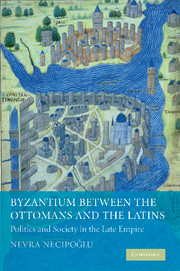Book contents
- Frontmatter
- Contents
- List of maps
- Acknowledgements
- Note on transliteration
- List of abbreviations
- Map 1 The Byzantine world in the fourteenth–fifteenth centuries
- Map 2 Byzantium and its neighbors, c. 1350
- Map 3 Byzantium and its neighbors after 1402
- PART I INTRODUCTION AND POLITICAL SETTING
- PART II THESSALONIKE
- 3 Social organization, historical developments, and political attitudes in Thessalonike: an overview (1382–1430)
- 4 Byzantine Thessalonike (1382–1387 and 1403–1423)
- 5 Thessalonike under foreign rule
- PART III CONSTANTINOPLE
- PART IV THE DESPOTATE OF THE MOREA
- Conclusion
- Appendix I Archontes of Thessalonike (fourteenth—fifteenth centuries)
- Appendix II “Nobles” and “small nobles” of Thessalonike (1425)
- Appendix III Constantinopolitan merchants in Badoer's account book (1436–1440)
- Appendix IV Members of the Senate of Constantinople cited in the synodal tome of August 1409
- Appendix V Some Greek refugees in Italian territories after 1453
- Bibliography
- Index
3 - Social organization, historical developments, and political attitudes in Thessalonike: an overview (1382–1430)
Published online by Cambridge University Press: 07 December 2009
- Frontmatter
- Contents
- List of maps
- Acknowledgements
- Note on transliteration
- List of abbreviations
- Map 1 The Byzantine world in the fourteenth–fifteenth centuries
- Map 2 Byzantium and its neighbors, c. 1350
- Map 3 Byzantium and its neighbors after 1402
- PART I INTRODUCTION AND POLITICAL SETTING
- PART II THESSALONIKE
- 3 Social organization, historical developments, and political attitudes in Thessalonike: an overview (1382–1430)
- 4 Byzantine Thessalonike (1382–1387 and 1403–1423)
- 5 Thessalonike under foreign rule
- PART III CONSTANTINOPLE
- PART IV THE DESPOTATE OF THE MOREA
- Conclusion
- Appendix I Archontes of Thessalonike (fourteenth—fifteenth centuries)
- Appendix II “Nobles” and “small nobles” of Thessalonike (1425)
- Appendix III Constantinopolitan merchants in Badoer's account book (1436–1440)
- Appendix IV Members of the Senate of Constantinople cited in the synodal tome of August 1409
- Appendix V Some Greek refugees in Italian territories after 1453
- Bibliography
- Index
Summary
In the early fourteenth century the social structure of Thessalonike incorporated, like most other Byzantine cities of the time, three distinct layers. The top layer comprised the landed aristocracy, both lay and ecclesiastical; below them were the mesoi, a “middle class” consisting of rich merchants, small landholders, minor functionaries, the small clergy, and those exercising independent professions; at the very bottom were the poor, to whose ranks belonged small artisans, manual laborers, and small cultivators. However, around the middle of the same century, following the loss of their landed possessions in Macedonia and Thrace successively to Serbian and Ottoman conquerors, members of the landholding aristocracy, who by tradition had always disdained trade and commerce, began to engage in commercial activities. When the fundamental distinction that separated aristocrats from rich middle-class merchants was removed in this manner, the term designating the middle class (οιʿ μέσοι) also disappeared from the sources. Consequently, in a society which became more and more characterized by commercial interests, the principal distinction that remained effective was that between the rich (including merchants, bankers, landowners) and the poor, who suffered from deep economic and social problems.
While the Ottoman invasions certainly played a decisive role in accelerating this sharp social and economic differentiation in Thessalonike, it must be pointed out that an atmosphere of civil discord prevailed in the city prior to and independently of the Ottoman threat, as demonstrated by the developments of the first half of the fourteenth century which culminated in the so-called Zealot movement.
- Type
- Chapter
- Information
- Byzantium between the Ottomans and the LatinsPolitics and Society in the Late Empire, pp. 41 - 55Publisher: Cambridge University PressPrint publication year: 2009



